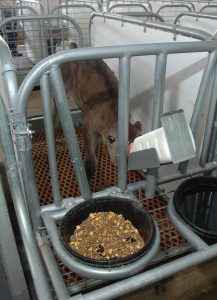In the 1930’s, dairymen believed it was important to separate the calf from its mother immediately after birth so it wouldn’t have problems learning to drink from a pail. They thought that calves are more difficult to train to drink from a pail after being exposed to nursing with the mom. In the 1950’s, dairymen also observed that calves that were allowed to nurse in open pens appeared to have increased prevalence of scours. Calf scours is diarrhea which has a variety of infectious and non-infectious causes. However, back in the 1950’s, there was a belief that scours was caused by excessive milk feedings which caused bacterial break-down in the gut and irritated the calves digestive tract, resulting in scours. Diarrhea prevents absorption of fluids from the intestine and leads to dehydration, acidosis, loss of electrolytes and may cause death if not treated effectively. Calf scours causes the most financial losses for cow-calf producers to manage than any other disease so dairymen are very motivated to avoid it. By separating the calf from its mother, they could control amount of milk the calf consumed as well as other environmental factors such as cleanliness. They limited milk feedings by giving low quantities of milk only twice a day. Conventionally, it was said that you should not give more than 10 pounds of whole milk per 100 pounds of live weight per day, divided into two feedings daily.
Research in the 1950s that compared different types of housing systems from individual, outdoor and group barn housing revealed that individual housing system was best for calf health due to less diarrhea and infections. As intensification occurred and dairy herds increased, occurrence of diseases such as diarrhea and respiratory diseases also increased. Throughout the 70s and 80s, individual housing for calves became very popular as it was believed to inhibit spread of infectious diseases and thus decrease mortality. Calves were typically housed in elevated stalls which are still used today and are made of steel or wood to keep them dry and clean with slatted flooring that allows excrement to wash away from the calf.
In the photo below, you can see an individually housed calf in an elevated stall in Texas is drinking from a bottle. Allowing calves to drink from a bottle is not common practice but should be implemented as will be discussed later.

